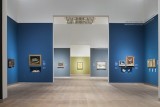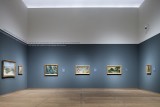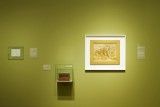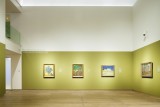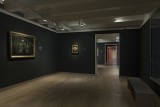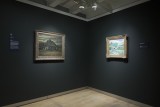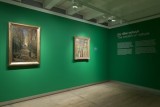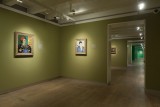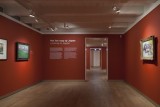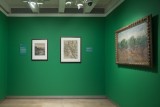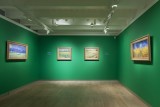The browser will either open the file, download it, or display a dialog.
Vincent: The Van Gogh Museum in the Hermitage Amsterdam
Hermitage, Amsterdam
September 29, 2012–April 25, 2013
In a recent article, feminist art historian and Van Gogh scholar Griselda Pollock recalled the first exhibition she ever visited, a major showing of the work of Van Gogh that took place at the Art Gallery of Ontario in Toronto in 1961. The exhibition followed a chronological and topographical trajectory from the “immiserated peasants” of the Dutch period through “the luminous streets, gardens and cafés of Paris” and the “saturated color and orgiastic brushwork” of Arles, to the final crescendo in Auvers, represented by the “modernist Golgotha [of] a wheat field menaced by crows.”[1] Such staging, she argues here, and elsewhere, presents Van Gogh’s oeuvre as little more than a mythical testimony to his biography. By taking Van Gogh’s peregrinations as its starting point, this type of presentation—still popular today—draws our attention to Van Gogh’s life, his trials and tribulations, and treats issues of art making, of what it means to be an artist with an artist’s concerns, as merely secondary. In other words, Van Gogh the man triumphs above Vincent the artist.
What would it do to Van Gogh’s work and to our understanding of his place in the canon of art history, however, if the tables were turned? If for once it was the painter who was foregrounded and not the suffering suicide? Although as teachers many of us have for years now emphasized Van Gogh’s production above his life story, this approach has yet to be tried in a museum environment, where in general chronology and geography remain the norm in display. This has certainly been true in the Van Gogh Museum, which owns the largest collection of Van Gogh’s works in the world, covering all periods, and where millions of visitors per year—a large number of whom have never been to an art museum before—need easy access to the work. This has meant that even though every effort has been made to de-emphasize the more dramatic aspects of the artist’s life, his biography has remained the organizing principle. The current closure of the museum for renovation provided the perfect opportunity for rethinking the installation of the collection, and for tackling questions of Van Gogh’s purely artistic pursuits. The results of this process, on view at the Hermitage’s Amsterdam branch until the museum reopens in early 2013, are impressive. Curators Leo Jansen and Renske Suijver have provided us with a new vision of the artist, one that is far more interesting than the clichéd image circulating in the popular media.
The curators’ intentions are announced already in the title of the exhibition. “Vincent,” of course, was how the painter signed his work, and was used only for those pictures he considered truly finished—a very small percentage of his oeuvre. The introductory wall text also makes it clear that this is an exhibition about Van Gogh as a hardworking, outward looking, and experimental artist, seeking to make a difference in the world and not to express his inner turbulence.
The exhibition is divided into seven themes, each of which focuses on Van Gogh’s artistic choices, ambitions, and painterly identities. Biographical information is relegated to a wall-filling timeline at the start of the show. Similarly, within the themes themselves, chronology and topography have been largely abandoned, with works from different periods hung side by side in order to emphasize the continuity of certain ideas and practices. Each room, or set of rooms, painted in an unusual range of colors from ochre to a jewel green, is introduced by a wall text explaining the theme (“Practice Makes Perfect,” “A Style of his Own,” and “Looking to Japan”). These are written in a lucid and convincing style that guarantees the viewer will not miss the usual biographical pathos. The topic is further elucidated by a well-chosen quotation, stenciled on the wall, and a relevant letter, in which, for example, Van Gogh describes his intention to become a peasant painter (490)* or his ideas about the modern portrait (879). Installing paintings in the same spaces as letters, drawings, and three-dimensional artifacts—the box of wool Van Gogh used to experiment with color combinations is the most precious—adds another layer to the exhibition concept, and of course provides a wonderful opportunity to view works not normally on display.
Highly innovative in terms of concept and presentation are the first three galleries, which deal with the most important aspects of Van Gogh’s development as an artist and his artistic practice. In “Practice Makes Perfect” we are introduced to Van Gogh as a life-long learner, an autodidact, but one who knew and understood the rules of art making and sought to make them his own (fig. 1). We see his first attempts at drawing and painting, and his efforts to learn to model with the help of that most academic of objects, the plaster cast. We come to understand that Van Gogh, like any good artist, prepared his canvases with preliminary studies. The color copies after Jean-François Millet, executed during his stay in the asylum at Saint-Rémy in 1889, are here shown not as illustrations of this troubled period in his life or as proof of his love of the peasant class, but as tools with a practical purpose; namely, as part of his ongoing experimentation with color.
“A Style of His Own” investigates Van Gogh’s continual search for a personal style, illustrating the various phases in this quest, but equally underlining certain continuities in practice from his earliest to his last works (fig. 2). The curators are thus able to demonstrate, for example, that the free, angular brushstrokes used to define an object so typical of his later paintings make their first appearance in a still rather traditional portrait of an old man painted in Antwerp (1885). While the influence of his fellow artists in Paris are made obvious, so too are Van Gogh’s idiosyncrasies such as the ways in which he sought to combine various techniques in order to distinguish himself from those around him. The grouping of works from different periods on one wall creates the impression not of a linear development, but rather of constant exploration (fig. 2). It becomes clear that on his death, Van Gogh was far from finished in his search; he had not yet found “his” style. This sets the tragedy of his suicide in a different and broader framework—it has an art historical as well as personal dimension—and undermines the notion of the late work as a culmination of a long and difficult struggle.
The third section dealing with Van Gogh’s artistic choices is entitled “The Effect of Colour” and again approaches a complex topic from a cool-headed angle. Here, Van Gogh’s intense palette is presented not as the product of the burning Arles sun, but as the result of calculated experiment, as demonstrated by the box of wool and Quinces, Lemons, Pears and Grapes (1887), in which he “tested” the effects of different yellows (fig. 3). The artist’s emphatic “[c]olour expresses something in itself” (537) forms the leitmotif for this gallery; for Van Gogh, color was not a means for expressing his own emotions, but a means of inducing them in others. The story told here by the Sunflowers (1889) and Gauguin’s Chair (1889) is not the story of the drama of the Yellow House (nowhere mentioned), but the story of the colors yellow, red, and green, and how an artist might employ them to evoke a particular mood (fig. 4).
The second floor of the exhibition is dedicated to Van Gogh’s different artistic identities—peasant painter, portraitist, landscape painter—with a further section devoted to the influence of Japan. In a series of smaller cabinets, the curators have again combined paintings, drawings and letters to give an impression of Vincent’s motivations, his aims and the means he employed in achieving them (fig. 5).
Van Gogh’s initial ambition was to be a painter of country life, of the life of those who worked the land, and of the seasons. Formed during his Dutch years and first expressed in the letter (490) that introduces the “Peasant Painter” section, it was nonetheless an ambition that remained with him throughout his career, as illustrated by the echoes we find of it as we move through the various rooms. This was undoubtedly one of the curators’ aims in their choice of works from the collection: not only to show the changes in Vincent’s artistic self-image, but also to establish a sense of continuity. The recurrence of various themes in different periods, such as the peasant cottage [The Cottage (1885) and View of Auvers (1890)] or autumn trees [Avenue of Poplars in Autumn (1884) and The Garden of Saint Paul’s Hospital/The Fall of the Leaves (1889)], indicates that at least some of Van Gogh’s preoccupations always remained the same (figs. 6 and 7). This challenges the notion of radical breaks within his development and again emphasizes that his work was more about the problems of art making than problems of the psyche.
The galleries devoted to portraiture reveal a similar variety and simultaneous permanency of approach (fig. 8). Vincent’s personal relationships with his sitters are de-emphasized, making room for an understanding of a picture like The Zouave (1888) as a study in color rather than a depiction of one of the artist’s only friends during his stay in Arles. A special place is naturally given to Van Gogh’s self-portraits, but here again, it is the ways in which these express his artistic identity –not his mental state—that are stressed. Self-Portrait as a Painter (1887–88), for example, is posited as an image of Van Gogh claiming for himself the status of modern artist (signified by the unmixed colors on the palette), rather than as the portrait of a man exhausted by the stimulus of urban life—a more conventional interpretation.
Situated between the “Peasant Painter” and “The Modern Portrait,” “Looking to Japan” also takes a novel approach to this aspect of Van Gogh’s development (fig. 9). Japan and Japanese art are presented not so much as a kind of dream utopia with which Van Gogh supposedly identified, but more specifically as a primary source of stylistic innovation. This is certainly not a particularly new insight, but by hanging pictures such as The Harvest (1888) in this section, the penetration of Japanese art into areas of Van Gogh’s work where it is usually neither noted nor stressed comes to the fore.
The final galleries examine Van Gogh as a landscape painter, the identity with which many viewers will most readily associate him. This section contains some interesting and illuminating pairings. In addition to the two autumn images mentioned above, there is another illustrating how the artist’s formal consideration of his subject was dictated by the motif itself (fig. 10); a close-up study of a tree trunk, Tree with Ivy in the Garden of the Asylum (1889), demands a more abstracted style than a more documentary view of a polder ditch, Ditch (1884). Such a comparison makes it particularly clear that Van Gogh was always, and above all, seeking a mode of expression that would accord with his subject matter and the emotional effect it was intended to produce.
The last gallery in the exhibition contains only four works—more would not have fit in any case—and crowns the curators’ efforts to put Van Gogh the artist into the limelight (fig. 11). Here the habituée of the Van Gogh Museum might well miss the dramatic highpoint of the famous double-square canvases all hung on one wall, but she is more than compensated by a new way of seeing the Wheatfield with Crows (1890), presented here (for the first time?) without an explanatory label analyzing whether it either is, or is not, Van Gogh’s last painting. Relieved of the burden of the biographical approach, one is free to view the work within the context of Van Gogh’s landscape oeuvre as a whole, with the effect that it becomes much less histrionic and foreboding. Instead, we come to see it as just one more experiment in color and perspective, far more related to the Arles work with which it is hung than one might have expected. The final work in the show is Wheatfield with Thunderclouds (1890), one of the most puzzling pictures Van Gogh ever painted: a menacing sky with fields bathed in that foreboding light so characteristic of a coming summer thundershower, yet at the same time meant to express what the artist could not “say in words, what I consider healthy and fortifying about the countryside” (898). That nature, even threatening nature, can be a comfort is a surprising and positive note on which to end a Van Gogh exhibition and creates an image of the artist that could not be more different from the tortured genius Griselda Pollock first encountered in 1961.
For many years now, of course, no one could accuse the Van Gogh Museum itself of actively propagating such an image. Yet it does live on, particularly in the popular imagination. At the same time, some of the ideas presented will undoubtedly seem obvious to scholars who are well acquainted with Van Gogh’s work, and therefore hardly in need of emphasis. The importance of the show, then, lies in how it might alter the views of those academics less familiar with these notions, and who perhaps have a certain aversion to Van Gogh due to his enormous popularity and the widespread image of him as a kind of martyr to modern art, the man “suicided by society,” as Antonin Artaud wrote.[2] More significantly, however, it may teach the public at large to see Van Gogh’s works in a new way, so that eventually Vincent the artist may come to have at least as much significance as Van Gogh the man. Only then, freed of the myth, will it be possible to truly assess his importance for the history of art. One can only hope that the museum takes this lesson to heart, and that when it returns to the Museumplein, it will not return to a simplifying biographical installation. The hoards of tourists, and we art historians as well, deserve a more nuanced Van Gogh.
The exhibition is accompanied by a publication, Vincent, written by curators Leo Jansen and Renske Suijver (Amsterdam: Van Gogh Museum Publications, 2012).
*Numbers in parentheses refer to Van Gogh’s letters; for the complete, annotated texts see www.vangoghletters.org.
Rachel Esner
Assistant Professor, University of Amsterdam
r.esner[at]uva.nl
[1] Griselda Pollock, “History versus Mythology: Reading Van Gogh for Dutchness” in R. Esner and M. Schavemaker, eds., Vincent Everywhere: Van Gogh’s (Inter)National Identities (Amsterdam: Amsterdam University Press, 2010), 53–54.
[2] Antonin Artaud, Van Gogh: le Suicidé de la Société (Paris: K éditeur, 1947).


